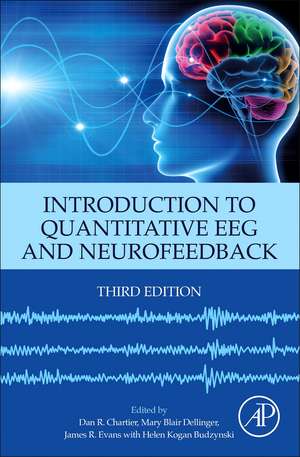Introduction to Quantitative EEG and Neurofeedback
Editat de Dan R. Chartier, Mary Blair Dellinger, James R. Evans, Helen Kogan Budzynskien Limba Engleză Hardback – 28 iun 2023
New chapters on smart-phone technologies and mindfulness highlight their clinical relevance. Written by top scholars in the field, this book offers both the breadth needed for an introductory scholar and the depth desired by a clinical professional.
- Covers neurofeedback use in depression, ADHD, addiction, pain, PTSD, and more
- Discusses the use of adjunct modalities in neurotherapy
- Features topics relevant to the knowledge blueprints for both the International QEEG Certification Board and International Board of Quantitative Electrophysiology
- Includes new chapters on photobiomodulation, smart-phone applications and mindfulness
Preț: 724.84 lei
Preț vechi: 892.80 lei
-19% Nou
Puncte Express: 1087
Preț estimativ în valută:
138.70€ • 151.13$ • 116.87£
138.70€ • 151.13$ • 116.87£
Carte tipărită la comandă
Livrare economică 16-30 aprilie
Livrare express 18-22 martie pentru 210.59 lei
Preluare comenzi: 021 569.72.76
Specificații
ISBN-13: 9780323898270
ISBN-10: 0323898270
Pagini: 592
Dimensiuni: 216 x 276 x 35 mm
Greutate: 1.73 kg
Ediția:3
Editura: ELSEVIER SCIENCE
ISBN-10: 0323898270
Pagini: 592
Dimensiuni: 216 x 276 x 35 mm
Greutate: 1.73 kg
Ediția:3
Editura: ELSEVIER SCIENCE
Public țintă
Neuroscientists, neurologists, neuropsychologists, clinical psychology practitioners and researchers, advanced neuroscience students, neurologists and psychiatrists, applicants pursuing QEEG Board certification.Cuprins
Section I. Raw EEG and QEEG and NFB Foundational Concepts
1. Electroencephalography microstates in relation to emotional decision-making
2. Quantitative electroencephalography clinical applications: A review and update
3. Electroencephalography imaging and biofeedback training using Z-Scores: databases and LORETA-based methods
4. Autonomic nervous system and the triple network: An evolutionary perspective with clinical implications
5. Taking a deeper look into the wiring of baby humans
6. When can you trust your beta: Detecting electromyography contamination of the electroencephalogram signal to enhance assessment of quantitative electroencephalogram and electroencephalogram training
7. Origins of electroencephalogram rhythms and implications for neurofeedback
8. History of the scientific standards of quantitative electroencephalography normative databases
9. Electroencephalogram neuroimaging, brain networks and neurofeedback protocols
10. Electroencephalogram in depth: Seeing psyche in brainwaves
11. Theories of brain functioning and the quantitative electroencephalography
Section II. Clinical Applications of NFB
12. Multiple channel advanced standardized weighted low-resolution electromagnetic tomography training for sustained clinical outcome
13. Utilizing quantitative electroencephalographic Assessment and standardized low-resolution brain electromagnetic tomography neurotherapy in the treatment of trauma and dissociation
14. Neurofeedback and developmental trauma: Theory and practice
15. Advances in analysis and training
16. The importance of contingency between electroencephalographic patterns and neurofeedback for sustained clinical outcome
17. Endogenous neuromodulation at infra-low frequencies
18. Neurofeedback in elite and athlete performance
19. Application of electroencephalogram and other neurophysiological measures in assessment of cue-reactivity in individuals with substance use disorder
20. Quantitative electroencephalogram, event-related potential and neurofeedback in substance use disorders research and treatment
21. Asperger’s syndrome intervention: Combining neurofeedback, biofeedback and metacognition
22. Effective intervention for attention-deficit/hyperactivity disorders using quantitative electroencephalography and neurofeedback 23. Alpha–theta neurotherapy and the neurobehavioral treatment of addictions, mood disorders, and trauma
Section III. Complementary Approaches and Adjunctive Concepts for Neuromodulation and NFB
24. Midstream exchange between the gastrointestinal system and the brain
25. pIR HEG neurofeedback and nIR HEG neurofeedback, best practices
26. “Wearables: A new age of personal empowerment
27. Optimal biofeedback: Combining neurofeedback and integrative neuromodulation through light, sound, vestibular/cerebellar stimulation and heart rate variability
28. Music and neuromodulation
29. Physiology of audio-visual entrainment technology
30. Lifestyle and environmental influences on electroencephalography, quantitative electroencephalography, and Neurofeedback
Section IV. Ethical and Legal Issues
31. Quantitative electroencephalography goes to court - Applications in liability and capital cases
32. Ethical principles in neurofeedback standards of care and clinical practice
1. Electroencephalography microstates in relation to emotional decision-making
2. Quantitative electroencephalography clinical applications: A review and update
3. Electroencephalography imaging and biofeedback training using Z-Scores: databases and LORETA-based methods
4. Autonomic nervous system and the triple network: An evolutionary perspective with clinical implications
5. Taking a deeper look into the wiring of baby humans
6. When can you trust your beta: Detecting electromyography contamination of the electroencephalogram signal to enhance assessment of quantitative electroencephalogram and electroencephalogram training
7. Origins of electroencephalogram rhythms and implications for neurofeedback
8. History of the scientific standards of quantitative electroencephalography normative databases
9. Electroencephalogram neuroimaging, brain networks and neurofeedback protocols
10. Electroencephalogram in depth: Seeing psyche in brainwaves
11. Theories of brain functioning and the quantitative electroencephalography
Section II. Clinical Applications of NFB
12. Multiple channel advanced standardized weighted low-resolution electromagnetic tomography training for sustained clinical outcome
13. Utilizing quantitative electroencephalographic Assessment and standardized low-resolution brain electromagnetic tomography neurotherapy in the treatment of trauma and dissociation
14. Neurofeedback and developmental trauma: Theory and practice
15. Advances in analysis and training
16. The importance of contingency between electroencephalographic patterns and neurofeedback for sustained clinical outcome
17. Endogenous neuromodulation at infra-low frequencies
18. Neurofeedback in elite and athlete performance
19. Application of electroencephalogram and other neurophysiological measures in assessment of cue-reactivity in individuals with substance use disorder
20. Quantitative electroencephalogram, event-related potential and neurofeedback in substance use disorders research and treatment
21. Asperger’s syndrome intervention: Combining neurofeedback, biofeedback and metacognition
22. Effective intervention for attention-deficit/hyperactivity disorders using quantitative electroencephalography and neurofeedback 23. Alpha–theta neurotherapy and the neurobehavioral treatment of addictions, mood disorders, and trauma
Section III. Complementary Approaches and Adjunctive Concepts for Neuromodulation and NFB
24. Midstream exchange between the gastrointestinal system and the brain
25. pIR HEG neurofeedback and nIR HEG neurofeedback, best practices
26. “Wearables: A new age of personal empowerment
27. Optimal biofeedback: Combining neurofeedback and integrative neuromodulation through light, sound, vestibular/cerebellar stimulation and heart rate variability
28. Music and neuromodulation
29. Physiology of audio-visual entrainment technology
30. Lifestyle and environmental influences on electroencephalography, quantitative electroencephalography, and Neurofeedback
Section IV. Ethical and Legal Issues
31. Quantitative electroencephalography goes to court - Applications in liability and capital cases
32. Ethical principles in neurofeedback standards of care and clinical practice
